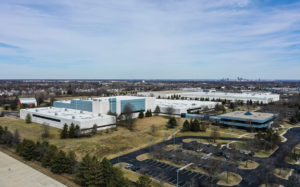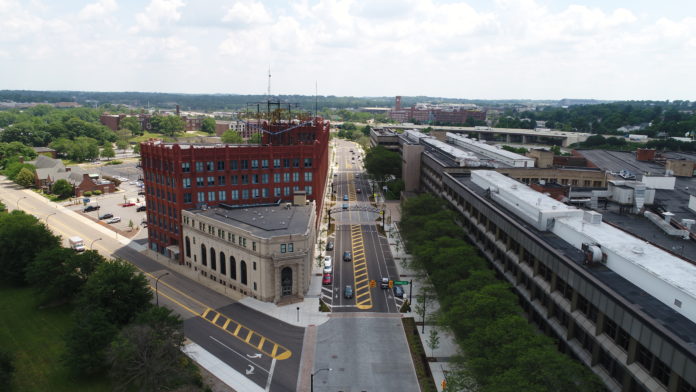Sawtelle-based Industrial Realty Group has completed a bond offering of $275 million, bringing its total financing in the last year to more than $1 billion.
The bond offering of $275 million was senior unsecured notes, which the commercial real estate development and investment company plans to use to refinance existing mortgages, reduce the cost of capital and secure low interest rates.
IRG has now received investments from more than 18 institutional investors, with Goldman Sachs & Co. and JPMorgan Chase & Co. serving as placement agents.
In March, the company got $335 million in private placement bonds and established a $200 million unsecured credit facility from JPMorgan Chase and Zions Bank.
“The last three or four years have been extremely strong in the industrial sector and for our company,” said John Mase, chief executive officer of IRG.
Today the company owns more than 100 million square feet of real estate across 32 states, roughly 70% of which is industrial. IRG buys 15 to 20 properties a year and only sells one or two in that time, usually to a tenant. Other properties sold may be nonindustrial assets that are part of a larger project.
“We buy a lot of really large properties, and sometimes the properties are mixed-use,” Mase said. “So, even though we are acquiring industrial, sometimes there are some office buildings that we sell or lease out.”
The company also has some residential and retail real estate in its portfolio.
IRG isn’t the only investor interested in industrial real estate. Experts agree that the product, especially in L.A., is in high demand.
David Wirgler, associate director of Stan Johnson Co., said “from an investor interset (standpoint), I don’t think we’ve seen a greater high for interest in industrial assets,” adding that investors viewed industrial real estate as being a safe asset type.
CBRE Group Inc. Vice Chairman Craig Peters agreed.
“Investor demand is high for quality product,” he said. “You have a lot of both private capital and institutional capital which are trying to get the same type of product, which is Class A industrial product. When you have a lot of bidders on a finite supply of assets, you tend to see some pretty significant value.”
Heavy renovations

Last year, IRG acquired roughly 8 million square feet of real estate. That included several facilities supporting ports, the International Exposition Center in Cleveland and an industrial project in Houston. Mase said the money raised recently would help with IRG’s continued growth and stabilization.

Less than half of the company’s portfolio is traditional, big-box ecommerce distribution centers. More than half of the portfolio is renovated buildings that include manufacturing plants.
Roughly 50% of IRG’s total portfolio is in the Midwest. The company has been expanding in areas like Seattle; Reno, Nev.; and the East Bay as well. Locally, the company has a project in Downey.
“Were very opportunist. We don’t just target one particular market,” Mase said.
IRG acquires, preserves and redevelops or repositions real estate using partnerships and limited liability companies.
Most of the real estate acquired by IRG, according to the company, is no longer needed by its owner and requires renovations in order to be needed in today’s market.
IRG has also worked on a number of environmentally challenging properties.
“We take the project and, depending on what they are, add new roofs, new loading docks, (work on) cleaning them up, fixing them up and making them work for today’s workforce,” Mase said of the changes IRG makes to properties it acquires.
IRG has also converted a number of federal properties, including closed military bases.
Its first was Sacramento’s McClellan Air Force Base, which IRG developed into a master-planned community dubbed McClellan Park.
IRG invested more than $200 million to rehabilitate the property to include 155 industrial buildings and 35 warehouses. The company operates the industrial and office space, an air museum, chapel, dorms, hotel, an airport and other facilities at the center.
IRG has redeveloped other Air Force bases and federal properties and most recently won a bid to work on a property in Auburn, Wash.
Locally, IRG’s project in Downey was a former NASA site that was operated as a studio space for seven years before IRG got entitlements to build on the land.
Competitive market
Mase said IRG is focusing on stabilizing its assets. He said the company had been on a “large buying spree the last few years” and was now working to shore up its assets.

The future is “going to depend on a lot of factors like interest rates, rental rates and the economy, but putting that large financing in place has really stabilized our company. We are continuing with strategic growth, and lately it’s been on the coasts,” Mase added.
The company now has 300 employees nationally and three main offices in addition to satellite offices and is looking to grow.
As for L.A., Mase said the market has some difficulties. The industrial market, especially in Southern California, has been on fire , as ecommerce has grown and as fast delivery promises by ecommerce companies have increased. L.A.’s proximity to busy ports, experts agree, is also part of why the local industrial market is so competitive.
In the fourth quarter, the vacancy rate for industrial properties in L.A. County was a mere 1.3%, down from 3.1% the year prior, according to data from Jones Lang LaSalle Inc. The asking rate for industrial properties was $1.12 on a triple net basis, up 15 cents in a year, JLL data shows.
Despite the high demand, only 4.1 million square feet was under construction in the county at the end of the year, a small percentage of the 778.1 million square feet of industrial product in L.A. County, according to JLL data.
“Prices right now are extremely high, so it’s pretty hard to jump in today with prices being where they are,” Mase said.
Wirgler agreed, adding that demand for industrial product was not slowing down.
“Part of the problem is, ‘Can developers continue to build more product to keep up with the demand from tenants?’” Wirgler said. “And one of the bigger problems we have is the pricing has gotten so unbelievably competitive due to the demand.”

